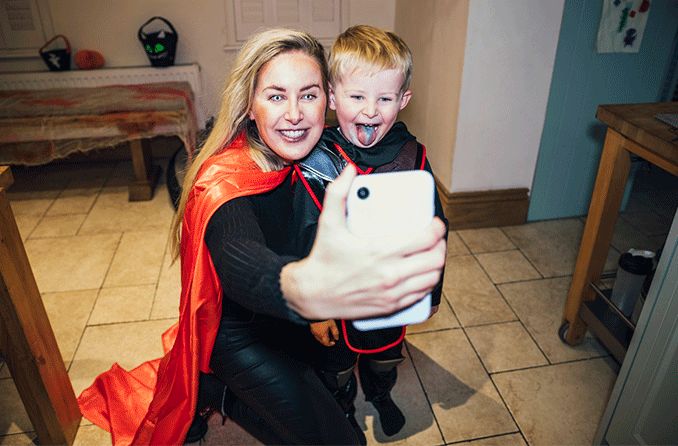Colored contacts for Halloween: Are they safe?

Halloween contact lenses may be just what you need to terrorize trick-or-treaters or wow party-goers this year. These fanciful colored contacts can take your startling or sassy costume to a whole new level. But they aren’t always safe and should be bought and worn with caution.
Are Halloween contacts safe?
Halloween contact lenses certainly aren’t harmless. Anything you place on your eyeball has the potential to cause an injury or infection that could lead to vision loss.

Costume contact lenses can be great for Halloween, but it's safest to order them through your eye doctor.
Decades of research and development have produced colored and costume contact lenses that are safe — when prescribed correctly, worn properly and maintained carefully.
But not all Halloween contacts fit these guidelines. The safety of these specialty lenses (also known as theatrical, special-effects or costume contacts) boils down to buying them from the right people and wearing them the right way.
“If they are purchased on the internet and aren’t fit by an eye doctor, then there are increased risks of complications like infection, scarring, blurry vision or loss of vision,” warns Dr. Brian Boxer Wachler, an ophthalmologist based in Beverly Hills.
Dr. Boxer Wachler cautions about lesser threats, too: irritation, dry eyes, red eyes and persistent discomfort that feels like there’s an eyelash in your eye.
Why go to all this trouble just to look like you’ve got the eyes of a cat, a lizard or an evil alien from a galaxy far, far away? Well, sometimes these crazy contacts are simply the perfect final touch to create fear, drama or whimsy with a fun or freaky costume.
The possibilities are virtually endless when it comes to colored and costume lenses designed to create ocular drama for Halloween.
But therein lies the danger. Some Halloween contacts are safer than others, but how do you know the difference?
What makes Halloween contact lenses harmful?
Costume contact lenses for Halloween are a twist on colored contact lenses, which allow people to tweak the color or tint of their eyes or transform them altogether. Some can even correct nearsightedness, farsightedness and/or astigmatism at the same time. Or, they can be unpowered, providing nothing more than “decoration.”
In the United States, all contact lenses — powered and unpowered — are considered medical devices. The only way to legally buy contact lenses is with a prescription from an eye doctor.
The potential for harm arises when costume contacts are bought through websites, convenience stores and other shopping venues that sell Halloween lenses without a prescription. This violates U.S. law, but that doesn’t prevent unethical vendors from selling Halloween contacts — or unaware customers from buying them.
The problem with buying colored contact lenses for Halloween illegally, without a prescription from an eye doctor, is that every eye has different dimensions. It’s reasonable to assume that whatever over-the-counter lenses you buy will be too loose or too tight, either of which could cause problems that lead to eye injuries or infections.
An eye doctor’s prescription, which provides precise measurements of the front surface of the eye, is the only way to ensure a proper fit. There’s no such assurance when buying illegal Halloween contacts — however cool they may look, whatever safety guarantees the retailer or brand may make.
“It’s not worth the risk,” Dr. Boxer Wachler warns. “Have an eye doctor order them or at least assess them before you put them on your eyes.”
What are the risks of wearing Halloween contacts?
TV shows and movies inspire inventive Halloween costumes. Vampires, werewolves, jungle cats, slithering reptiles — just about anything with eyes is fair game for costume professionals in the entertainment industry. And the wilder the character or creature… the wilder the contacts.
It’s only natural to desire this same effect in your own Halloween costume. Brands and products have sprung into action to meet this demand. But keep in mind, ethical businesses selling Halloween contacts and operating under U.S. laws will require buyers to provide a prescription from an eye doctor.
Once again, there are retailers online and in stores that sell costume contacts without prescriptions. The companies selling these lenses may be operating beyond the jurisdiction of U.S. law or unaware of (or unconcerned with) the dangers. If you buy these over-the-counter contact lenses, you’re setting yourself up for eye discomfort or, worse, injury or infection.
The American Academy of Ophthalmology (AAO) cited case studies with the following outcomes from wearing over-the-counter contacts:
A teenage boy was blinded in one eye.
A teenage girl was hospitalized for a week.
A woman suffered vision loss after wearing the lenses for 10 hours.
AAO warns that poor-fitting lenses can lead to abrasions or ulcers on the cornea — the clear half-dome on the front of the eyeball. These corneal injuries can cause permanent vision loss. Another risk is keratitis — a painful bacterial infection.
These illegal lenses “also might let less oxygen through to the eye, because the paints and pigments used to add color make the lenses thicker and less breathable,” AAO cautions.
Symptoms of problems when wearing Halloween contacts include:
Pain
Red eyes
Blurry vision
Difficulty with removal — the lens getting “stuck” on the eye
Lens not staying on the eye
Safety tips for prescription Halloween contacts
These tips should help you avoid eye damage when wearing prescription Halloween contact lenses.
See an eye doctor first. Make sure your eyes are suitable for contacts and have your eye doctor prepare a prescription based on your eyes’ precise shape and size.
Buy from the right businesses. Eye care professionals may be able to sell Halloween contacts to you directly, or they can recommend a brand or website.
Do as you’re told. Follow your eye doctor’s directions regarding safety, comfort and lens maintenance. Most of these lenses are for day use only and not to be slept in. Make sure you clear this up with your eye doctor.
Never share. You don’t want any of your friends’ germs infecting your eyes, or vice versa, by sharing contact lenses.
Don’t ignore problems. Redness, swelling or discomfort are your body’s way of telling you to remove the lenses immediately. You could have or develop a dangerous infection, especially if you keep wearing them despite these signs.
Play it safe with false eyelashes. Fake lashes can irritate the eyes, especially if you’re also wearing costume contact lenses. Follow the manufacturer’s directions closely.
SEE RELATED: Can fake eyelashes cause eye infections?
There’s nothing thrilling about endangering your eyesight
The whole point of Halloween is mixing fun with fright.
Whether you’re covering only the colored part of your eye or the entire font surface, you can definitely ramp up your look with Halloween contacts. And these costume lenses don’t have to strike fear into the hearts of those around you. Contact lenses can be customized with just about any image: from sports team logos to national flags to the moon and stars.
If you’re already comfortable wearing contact lenses, you may be a prime candidate for costume contacts. If you’ve never worn contacts, then you might want to be more cautious before trying them out at this year’s Halloween party.
Whatever you do, don’t forget your eyesight is riding on you making the right decision about what you put in your eyes. Buy your lenses the right way, with a prescription from your eye doctor and from a reputable seller. Never buy them over-the-counter — it’s not only illegal, it could be dangerous.
Follow these guidelines, and you’ll find yourself on the safest path to clear vision long after the moon has set on the fun and frights of whatever your Halloween festivities.
READ NEXT: Cosplay contacts
‘Colored’ and decorative contact lenses: A prescription is a must. U.S. Food and Drug Administration. Accessed August 2021.
Keep your eyes safe on Halloween. Centers for Disease Control and Prevention. Accessed August 2021.
Are costume contacts safe? American Academy of Ophthalmology. September 2020.
Decorative contact lenses for Halloween and more. U.S. Food and Drug Administration. Accessed August 2021.
Page published on Thursday, September 2, 2021






